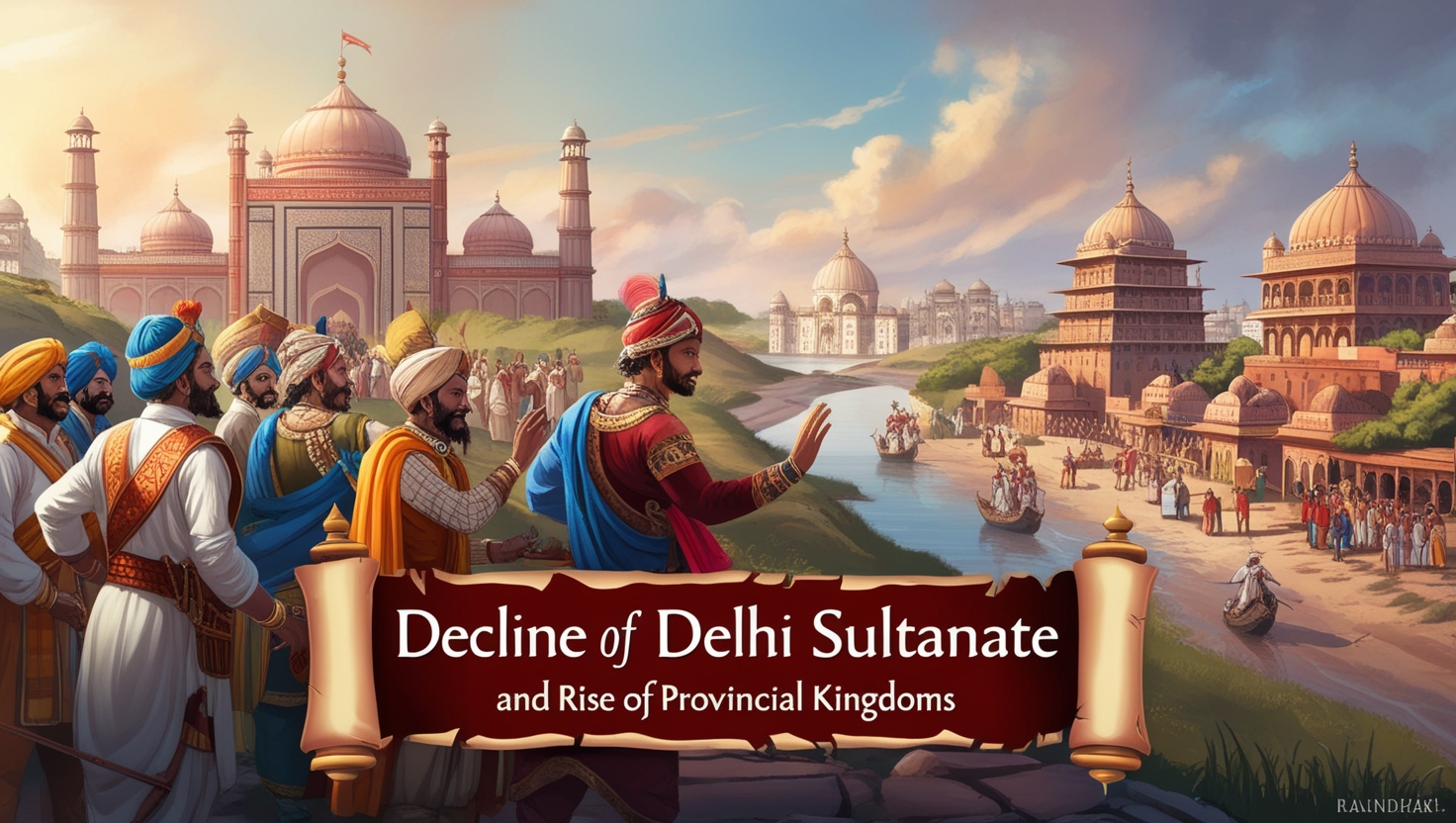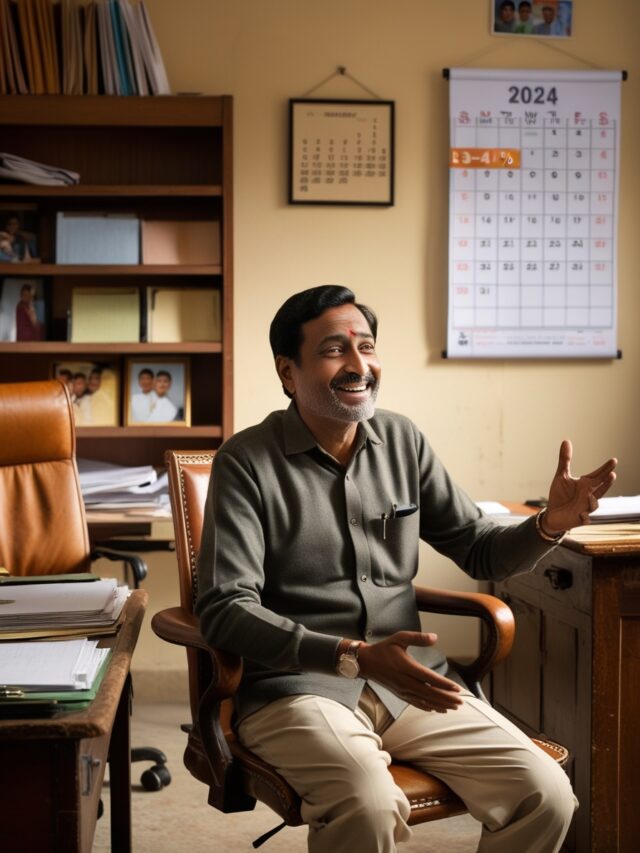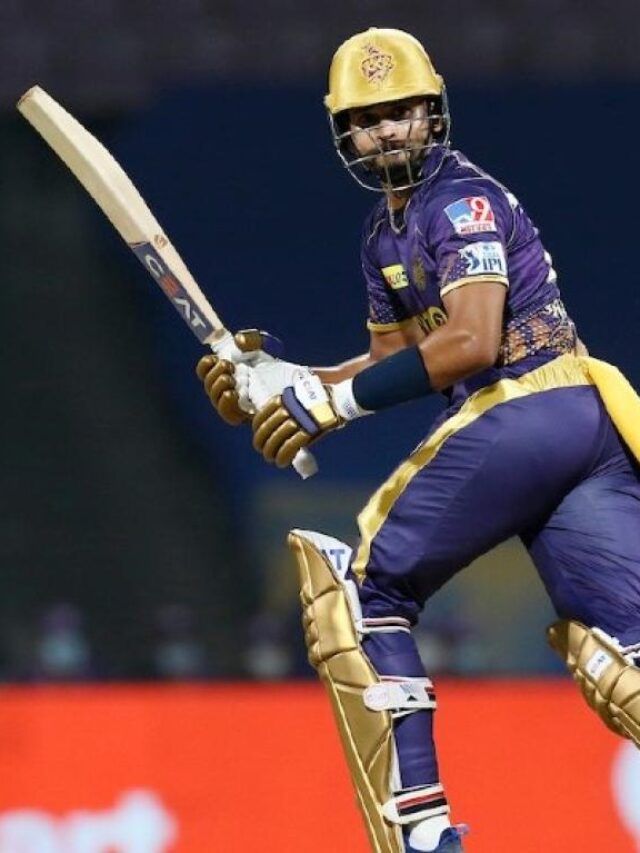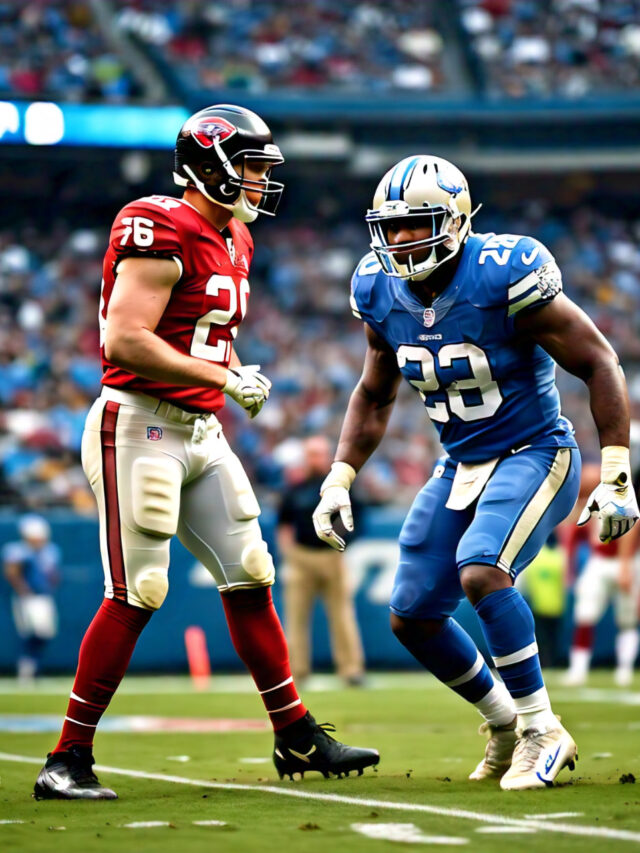
1. Which of the following states was one of the earliest to assert its independence from the Delhi Sultanate?
- Jaunpur
- Gujarat
- Bengal
- Malwa
Show Answer
Answer: Jaunpur
After the death of Firuz Shah Tughluq, the Tughlaq dynasty began to disintegrate, leading to several provinces asserting their independence. Jaunpur was among the earliest states to declare its independence from the Delhi Sultanate. This marked the fragmentation of the once-unified empire into various regional powers.
2. Which of the following sultans founded the city of Jaunpur?
- Ghiyasuddin Tughlaq
- Firoz Shah Tughlaq
- Mohammad Bin Tughlaq
- Ghiyaddin Tughlaq Shah II
Show Answer
Answer: Firoz Shah Tughlaq
Firoz Shah Tughlaq, during his reign, established the city of Jaunpur and named it after his cousin, Jauna or Juna Khan, also known as Muhammad bin Tughluq. Jaunpur evolved into a robust military power during the rule of the Sharqi dynasty.
3. Who founded the independent Jaunpur Sultanate?
- Ibrahim Shah
- Mahmud Shah
- Khwajah-i-Jahan Malik Sarwar
- Hussain Shah
Show Answer
Answer: Khwajah-i-Jahan Malik Sarwar
The independent Jaunpur Sultanate was founded by Khwajah-i-Jahan Malik Sarwar, a member of the Sharqi dynasty. He seized the opportunity presented by the Tughlaq dynasty’s disintegration to become an independent ruler, extending his authority over Awadh and a substantial portion of the Ganga-Yamuna Doab.
4. Who was the first member of the Sharqi dynasty to assume the royal title?
- Malik Sarwar
- Mubarak Shah
- Ibrahim Shah
- None of the above
Show Answer
Answer: Mubarak Shah
Malik Sarwar, initially the governor of the Jaunpur region, and his adopted son, Mubarak Shah, established the Sharqi dynasty to quell unrest in the Sultanate. After Malik Sarwar’s death, Mubarak Shah succeeded him and assumed the royal title, becoming the first member of the Sharqi dynasty to do so.
5. The Atal Devi Masjid in Jaunpur was constructed during the reign of which of the following kings?
- Malik Sarwar
- Mubarak Shah
- Ibrahim Shah
- Khizr Khan
Show Answer
Answer: Mubarak Shah
The Atal Devi Masjid in Jaunpur was constructed during the reign of Mubarak Shah, a ruler of the Sharqi dynasty. Originally, the masjid was a temple dedicated to the goddess Atala Devi. However, it was partially destroyed and converted into a mosque during Mubarak Shah’s rule, reflecting the cultural and religious transformations of the era.
6.The Third Rock Edict of Ashoka mentions Pradeshikas, Rajukas, and Yuktas. These officials were appointed to perform duties such as preaching dhamma and going on tours of inspection every five years. They also adopted a liberal attitude towards Brahmanas and Shramanas.
- Fourth Edict
- Fifth Edict
- Sixth Edict
- Seventh Edict
Show Answer
Answer: Fourth Edict
In the Fourth Major Rock Edict of Ashoka, the term Bheri Ghosha, which means war drum, was replaced by Dhamma Ghosha. Ashoka attached great value to this duty.
7. Which of the following rulers founded the city of Ahmedabad?
- Husang Shah
- Muhammad Shah II
- Ahmad Shah I
- Ahmad Shah II
Show Answer
Answer: Ahmad Shah I
Ahmad Shah I was an ambitious ruler who reorganized the administrative system of his kingdom and founded the city of Ahmedabad. He established the modern city of Ahmedabad on the site of the old town of Aswal and made it his capital, contributing to the city’s historical significance.
8. Which of the following rulers took the title of Mahmud Begarha?
- Ahmad Shah I
- Ahmad Shah II
- Mahmud Shah I
- Hasan Khan
Show Answer
Answer: Mahmud Shah I
Sultan Mahmud Begada, also known as Mahmud Shah I, assumed the title of Mahmud Begarha and succeeded to the throne in 1458 CE, where he ruled Gujarat.
9. Who destroyed the Dwarkadhish temple in Dwarka?
- Ahmad Shah II
- Mahmud Shah I
- Ahmad Shah I
- Hasan Khan
Show Answer
Answer: Mahmud Shah I
Mahmud Shah I, also known as Mahmud Begarha, was responsible for the destruction of the Dwarkadhish temple in Dwarka, Gujarat, marking a significant historical event in the region.
10. Which of the following was appointed as the governor of Malwa by Firuz Shah Tughluq?
- Zafar Khan
- Husang Shah
- Dilawar Khan
- Ahmad Shah
Show Answer
Answer: Dilawar Khan
Dilawar Khan Ghur, initially appointed as the governor of Malwa by Firuz Shah Tughluq, later declared his independence from the Delhi Sultanate, contributing to the regional fragmentation.
Q11: Narmadapur was founded by which of the following kings?
1. Mahmud Khalji
2. Hoshang Shah
3. Ghiyas-ud-Din
4. None of the above
Show Answer
Answer: 2
Explanation: Hoshang Shah, the ruler of Malwa, founded the city of Narmadapur, which is known today as Hoshangabad in Madhya Pradesh, highlighting his historical legacy.
Q12: Who was the last sultan of Malwa?
1. Baz Bahadur
2. Mahmud Shah II
3. Shujaat Khan
4. Qadir Shah
Show Answer
Answer: 1
Explanation: Baz Bahadur, the son of Shujaat Khan, declared his independence and became the last sultan of Malwa. His rule marked the closing chapter of Malwa’s history as an independent sultanate.
Q13: Medhpaat was the earlier name of which of the following kingdoms?
1. Malwa
2. Mewar
3. Kashmir
4. None of the above
Show Answer
Answer: 2
Explanation: The name Medhpaat evolved into Mewar over time, representing the transformation of the region’s name in its historical context.
Q14: Which of the following considered themselves as the custodians of the Hindu civilization?
1. Rulers of Malwa
2. Rulers of Mewar
3. Rajput Rulers
4. None of the above
Show Answer
Answer: 2
Explanation: The rulers of Mewar, also known as Maharana, considered themselves as the custodians of the Hindu civilization, epitomized in the temple of their lord Eklingaji.
Q15: Which god was Medhpateshwar?
1. Lord Shiva
2. Lord Vishnu
3. Lord Agni
4. Lord Brahma
Show Answer
Answer: 1
Explanation: Medhpateshwar, also known as Medhpateshwar or Lord of Medhpath, is a manifestation of Lord Shiva. The rulers of Mewar believed themselves to be custodians of the Hindu civilization, epitomized in the temple of Lord Eklingaji, a form of Lord Shiva.
Q16: The second Guhila dynasty of Chittor was established by which of the following kings?
1. Alauddin Khalji
2. Rana Hammira
3. Rana Kumbha
4. Maharana Mokal
Show Answer
Answer: 2
Explanation: After the defeat of Chittorgarh by the armies of Sultan Alauddin Khalji, Mewar became relatively insignificant. In 1335 CE, Rana Hammira established the Second Guhila dynasty of Chittor.a
Q17: To mark the victory of his conquests, Rana Kumbha erected a Victory Tower at which of the following places?
1. Ajmer
2. Jaipur
3. Chittor
4. Amber
Show Answer
Answer: 3
Explanation: Rana Kumbha erected a Victory Tower at Chittor to commemorate the victories in his conquests.
Q18: Which of the following kings was also acclaimed as Sangeet Shiromani?
1. Rana Kumbha
2. Rana Hammira
3. Maharana Pratap
4. Maharana Mokal
Show Answer
Answer: 1
Explanation: Rana Kumbha, the ruler of Mewar, was acclaimed as Sangeet Shiromani due to his patronage of art, literature, and music. He was a great musician and veena player.
Q19: Sangeet Mimansa, Sangeet Ratnakar, and Sudprabandh are works of which king of Rajputana?
1. Rana Kumbha
2. Rana Hammira
3. Maharana Pratap
4. Maharana Mokal
Show Answer
Answer: 1
Explanation: Rana Kumbha, the ruler of Mewar, was not only a political leader but also a prominent patron of the arts. He is known for his significant works such as Sangeet Mimansa, Sangeet Ratnakar, and Sudprabandh, which contribute to the understanding of music and literature in medieval India.
Q20: Which of the following kings constructed the city of Basantpur?
1. Rana Hammira
2. Maharana Pratap
3. Maharana Mokal
4. Rana Kumbha
Show Answer
Answer: 4
Explanation: Rana Kumbha is celebrated for his architectural achievements. He constructed the city of Basantpur, which included inns, palaces, ponds, schools, and temples. His contributions significantly enriched the cultural and architectural heritage of his region.
Q21: Achalgarh fort in Rajasthan was built by which King?
1. Bappa Rawal
2. Rana Hammira
3. Maharana Mokal
4. Rana Kumbha
Show Answer
Answer: 4
Explanation: Rana Kumbha, also known as Kumbhakarna Singh, constructed the Achalgarh fort in Rajasthan. He also built other forts like Kumbhalgarh, Maddan, Kolana, and Vairat for the defense of his kingdom.
Q22: In which year did Taimur invade India?
1. 1399
2. 1395
3. 1398
4. 1390
Show Answer
Answer: 3
Explanation: In 1398, Taimur, also known as Timur, invaded India, and his campaign had a profound impact on the Delhi Sultanate. His invasion weakened the Sultanate, contributing to its disintegration and the emergence of regional powers.
Q23: Which is the only state that maintained an independent kingdom throughout the Sultanate period?
1. Gujarat
2. Bengal
3. Orissa
4. Assam
Show Answer
Answer: 3
Explanation: Throughout the Sultanate period, the kingdom of Orissa remained independent and did not come under the direct control of the Delhi Sultanate. It maintained its sovereignty and distinct identity.
Q24: Other than Sonargaon and Satgaon, what was the third administrative division of Bengal during medieval India?
1. Birati
2. Lakhnauti
3. Panchimgaon
4. Gauda
Show Answer
Answer: 4
Explanation: Bengal, during the Delhi Sultanate, was divided into three administrative divisions: Lakhnauti (North Bengal), Sonargaon (East Bengal), and Gauda (South Bengal), reflecting the administrative divisions of the time.
Q25: Until which year was Bengal ruled by Ethiopians?
1. 1494
2. 1495
3. 1496
4. 1497
Show Answer
Answer: 1
Explanation: Bengal was ruled by Ethiopians until the year 1494 when Alauddin Hussain Shah, an Arab, rose to power in their service. His rise marked the end of Ethiopian rule in Bengal.
Q26: Alauddin Hussain Shah was regarded as the greatest independent Muslim ruler of which region in the aftermath of the Delhi Sultanate?
1. Gujarat
2. Bengal
3. Deccan
4. Malwa
Show Answer
Answer: 2
Explanation: Alauddin Hussain Shah is highly regarded as the greatest independent Muslim ruler of Bengal. His rule was marked by significant patronage of learning, Bengali literature, and his ability to win the hearts of his subjects, including both Hindus and Muslims.
Q27: Who succeeded Bengal after the termination of the Hussain Shahi dynasty of Bengal?
1. Sher Shah Suri
2. Sher Khan
3. Gullak Iqbal
4. Sheikh Bilal Suri
Show Answer
Answer: 1
Explanation: Following the Hussain Shahi dynasty’s termination in Bengal, Sher Shah Suri succeeded and took control of the region, establishing the Sur Empire. Sher Shah Suri is renowned for his administrative and military achievements.
Q28: Who was the famous Portuguese traveler who came during the Suri Dynasty?
1. Gangpae Herta
2. Nelmela Bibri
3. Saltamaria
4. Duarte Barbosa
Show Answer
Answer: 4
Explanation: Duarte Barbosa, a famous Portuguese traveler, visited Bengal during the Suri Dynasty. He provided detailed accounts of the prosperity and lifestyle of the people in Bengal during that period, offering valuable historical insights.
Q29: What are the names of two important Hindu kingdoms of Assam after Khalji’s reign?
1. Kanka & Ahom
2. Ahom & Kamrup
3. Alohi & Kamata
4. None of the above
Show Answer
Answer: 2
Explanation: After the Khalji dynasty’s reign, two notable Hindu kingdoms in Assam were the Ahom and Kamrup, known as Kamata in Persian chronicles. These kingdoms played a crucial role in the history of Assam.
Q30: Which place is considered to be the probable capital of Kamrup in Assam?
1. Guwahati
2. Shillong
3. Mirbari
4. Girja
Show Answer
Answer: 1
Explanation: Guwahati is considered the probable capital of Kamrup, also known as Kamata, in Assam, underlining its historical significance in the region.
Q1
Show Answer
answer
Q31: The independent chiefs who ruled small areas or regions in Assam were called:
1. Harbirat
2. Zamindar
3. Pir
4. Bhuyans
Show Answer
Answer: 4
Explanation: The independent chiefs who ruled small areas or regions in Assam were called Bhuyans. They played a vital role in the local governance and regional dynamics of Assam.
Q32: Who founded the Suryavansi Gajapati dynasty?
1. Hathiram
2. Raichand
3. Mihirendra
4. Kapilendra
Show Answer
Answer: 4
Explanation: Kapilendra, one of the ministers of the last Ganga ruler Bhanudeva IV, seized the throne and established the Suryavansi Gajapati dynasty in Odisha. This marked a significant political change in the region.
Q33: Who was the last great ruler of the Suryavansi Gajapati dynasty?
1. Pratap Rudra Gajapati
2. Virmohan Gajapati
3. Hathiram Gajapati
4. None of the above
Show Answer
Answer: 1
Explanation: Pratap Rudra Gajapati, who reigned from 1497 to 1540, was the last significant ruler of the Suryavansi Gajapati dynasty in Odisha, marking the end of this dynasty’s influence in the region.
Q34: Who translated Rajatarangini into the Persian language?
1. Girkamal
2. Bibhur
3. Jonaraja
4. Panini
Show Answer
Answer: 3
Explanation: Jonaraja, with the patronage of Sultan Sikandar of Kashmir, continued the translation of Kalhana’s Rajatarangini into Persian, extending it up to the year 1458. This work is an essential source for the historical and cultural understanding of the Kashmir region.
Q35: Who was Delhi’s first Afghan ruler?
1. Bahlul Lodi
2. Ibrahim Lodi
3. Muhammad Ghori
4. Bilal Raess
Show Answer
Explanation: Bahlul Lodi, who ruled from 1451, was the first Afghan ruler of Delhi and established the Lodi dynasty. His reign marked a significant chapter in the history of North India.
Q36: Who was Dilawar Khan?
1. Founder of Jaunpur
2. Founder of Kashmir
3. Founder of Khandesh
4. Founder of Malwa
Show Answer
Answer: 4
Explanation: Dilawar Khan, initially a noble under Firuz Tughluq, went on to establish the kingdom of Malwa, contributing to the regional fragmentation during the Sultanate period.
Q37: What was the title given to Sultan Alp Khan?
1. Baadshah
2. Hushang Shah
3. Sher Shah
4. None of the above
Show Answer
Answer: 2
Explanation: Alp Khan, the son of Dilawar Khan, became the Sultan of Malwa with the title Hushang Shah, furthering the region’s independent rule.
Q38: What was the capital of Malwa during Dilawar Khan’s rule?
1. Dhar
2. Birha
3. Munad
4. Kakkubina
Show Answer
Answer: 1
Explanation: Dhar served as the capital of Malwa during the reign of Dilawar Khan, marking an administrative center of the Malwa Sultanate.
Q39: What was the capital of Malwa during Dilawar Khan’s rule?
1. Dhar
2. Birha
3. Munad
4. Kakkubina
Show Answer
Answer: 1
Explanation: Dhar was the capital of Malwa during Dilawar Khan’s rule.
Q40: Where was the capital of Malwa transferred to during Hushang Khan’s time?
1. Dhani
2. Kochi
3. Parvatha
4. Mandu
Show Answer
Answer: 4
Explanation: During Hushang Khan’s time, the capital of Malwa was transferred from Dhar to Mandu.
Q41: Who established the Khalji dynasty in Malwa Sultanate, replacing the Ghurid dynasty in 1436?
1. Bakhtiyar Khilji
2. Muahmud Khalji
3. Alauddin Khalji
4. Ghiyas-ud-Din Khalji
Show Answer
Answer: 2
Explanation: Muahmud Khalji established the Khalji dynasty in the Malwa Sultanate in 1436, replacing the Ghurid dynasty.
Q42: Who was appointed as Mahmud II’s Wazir in order to frustrate the intrigues of his Muslim noblemen?
1. Biswadhrama
2. Panini
3. Gangadhar
4. Medini Rai
Show Answer
Answer: 4
Explanation: Mahmud II, the ruler of Malwa, appointed Medini Rai, the Rajput chief of Chanderi, as his Wazir to navigate the political intrigues within his administration. This marked a notable phase in the governance of Malwa.
Q43: In which year did Bahadur Shah of Gujarat capture Mandu?
1. 1530
2. 1531
3. 1532
4. 1533
Show Answer
Answer: 2
Explanation: Bahadur Shah of Gujarat captured Mandu in March 1531, and Malwa remained under the control of Gujarat for six years until Bahadur Shah’s death in 1537, reflecting the regional power dynamics of the time.
Q44: Which Malwa Sultan was titled Qadir Shah?
1. Ibrahim Khan
2. Anwar Shah
3. Mallu Khan
4. Iqbal Shah
Show Answer
Answer: 3
Explanation: Mallu Khan, who ruled as Qadir Shah, was a Farsi-speaking ruler of Malwa. He pursued diplomacy by making peace with Silahdi’s sons and improving relations with Rajput chieftains, contributing to regional stability.
Q45: In which year did the Battle of Chaul take place?
1. January 1508
2. March 1508
3. January 1580
4. March 1580
Show Answer
Answer: 1
Explanation: The Battle of Chaul in January 1508 saw the victory of the governor of Junagarh and the Egyptian fleet sent by the Mamluk Sultan. This battle had maritime and regional implications during this period.
Q46: Who was made the Sultan of Chittore by Bahadur Shah?
1. Zaimed Khan
2. Muhammad Kabir
3. Anwar Shah
4. Rumi Khan
Show Answer
Answer: 4
Explanation: Rumi Khan, a Turkish gunner initially made the Sultan of Chittor by Bahadur Shah, later betrayed him, showcasing the complex alliances and betrayals within regional powers.
Q47: Where was the capital of Mewar under the Guhilot dynasty in the post-Delhi Sultanate era?
1. Jaipur
2. Jaisalmer
3. Champak
4. Nagada
Show Answer
Answer: 4
Explanation: Under the Guhilot dynasty, the capital of Mewar in the post-Delhi Sultanate era was Nagada, emphasizing its historical and political significance.
Q48: Who wrote commentaries on Jayadeva’s Gitagovinda?
1. Kumbha
2. Gajanana
3. Pratap Singh
4. Virvrajabala
Show Answer
Answer: 1
Explanation: Raja Kumbha, a noted ruler of Mewar, wrote commentaries on Jayadeva’s Gitagovinda, as well as on Chandisatakam, contributing to the literature and cultural heritage of his region
Q49: Which Mewar king fought against both the Sultan of Malwa and the Sultan of Gujarat?
1. Manindra Singh
2. Sherbahadur Singh
3. Pratap Rudra Singh
4. Sangram Singh
Show Answer
Answer: 4
Explanation: Sangram Singh (1509-1528), the king of Mewar, engaged in conflicts with both the Sultan of Malwa (Mahmud Khalji II) and the Sultan of Gujarat (Muzaffar Shah II), reflecting the military and regional rivalries of the time.
Q50: What was the Hindu king of Calicut called in Malayalam in medieval India?
1. Samadira
2. Kirakartha
3. Samutiru
4. Lalminak
Show Answer
Answer: 3
Explanation: In Malayalam, the Hindu king of Calicut was referred to as Samutiru, but the Arabs called him Samuri, signifying the variations in how different cultures referred to the same historical figure, meaning sea-king.







